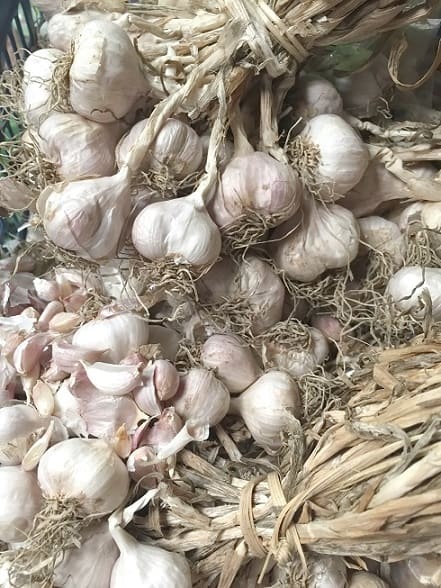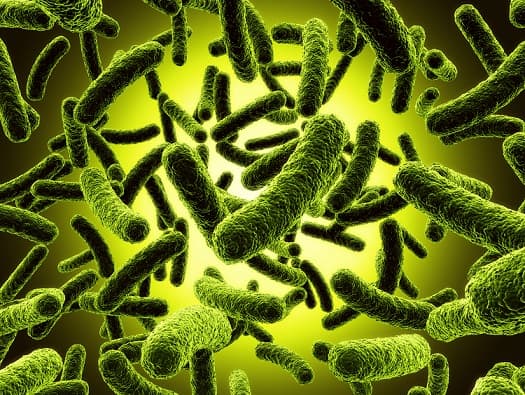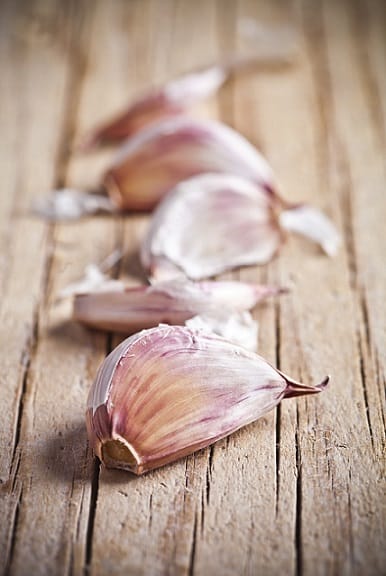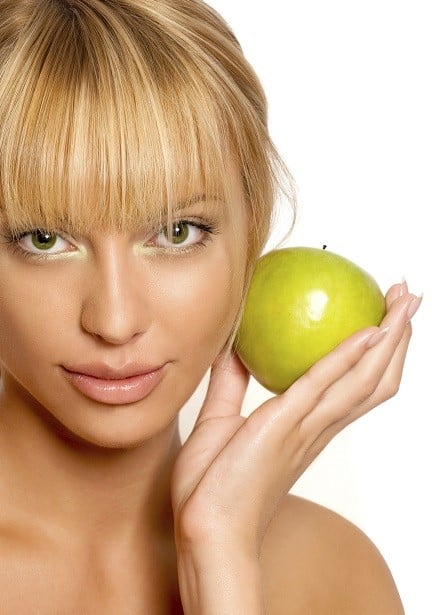 Today’s post will be about whether adding garlic to your diet is a sound acne strategy. The short answer is – this bulbous root is absolutely amazing.
Today’s post will be about whether adding garlic to your diet is a sound acne strategy. The short answer is – this bulbous root is absolutely amazing.
Garlic’s history of medicinal power is almost as strong as its pungent, vampire-scaring aroma. It was revered for its health properties in Ancient Egypt and Babylon 4500 years ago, and first appeared in cooking around 4000BC.
In Medieval times, raw garlic was taken for drunkenness and greed. Later, the English would eat a whole clove to ward off the Black Death. By 1858, the famous Louis Pasteur was preaching about garlic’s antifungal and antibacterial powers.
Today, garlic has hundreds of documented health powers. One is warding off disease-ridden mosquitoes; merely consuming garlic will kill them, as the scent leaves your pores. Sub-Saharan Africans everywhere are eating it.
In America, there’s even a chewable dog food called Bug Off Garlic, to give your dog a mosquito forcefield. Its potency against these blood sucking insects is presumably how people realised that vampires hate it…
…and there’s one other pest that garlic can vanquish – our old friend acne.
Garlic slashes inflammation!
By far the most famous medicinal compound in garlic is the sulphur based allicin. Garlic is a highly sulphurous food in general thanks to its many thiosulphanates, dithiins, and sulfoxides, but allicin forms roughly 70-80% of garlic’s total thiosulphanates. It also provides much of garlic’s pungent aroma.
Why is allicin so fantastic for acne? As your stomach digests allicin, it rapidly breaks down into sulfenic acid. That’s an antioxidant, and a particularly potent one; this study found that sulfenic acid reacts with free radicals faster than any other substance known to mankind.
Read Annihilate Your Acne – get the ultimate diet and clear your acne permanently!
The happy result for your skin is more antioxidants available to defend against it. It also boosts glutathione, the body’s master antioxidant, which you manufacture yourself, but acne patients commonly lack. Sulphur is a key ingredient of glutathione, and garlic is packed with it. The same goes for garlic’s friend the onion.
Allicin isn’t the only one with unique benefits either, as another sulphurous compound in garlic is thiacremonone. This study found that thiacremonone inhibited both NF-kappaB and cyclogenase-2 (COX-2), two immune system master molecules which control a vast swathe of pro-inflammatory chemicals. Thus, thiacremonone “could be a useful agent for the treatment of inflammatory and arthritic diseases”.
The advantage – arthritis is classic disease of chronic inflammation, and so is acne. There are arthritis sufferers on the internet right now taking highly concentrated garlic pills. If you know anybody with arthritis, then feed them garlic!
Yet another sulphurous compound is 1,2-vinyldithiin (1,2-DT). Compared to thiacremonone, the exact mechanism is less clear, but this study found that 1,2-DT inhibited numerous pro-inflammatory chemicals in human cells. Interleukin-6, which acne prone skin has much higher amounts of than average, was reduced by 26%. The scientists concluded that “1,2-DT, a garlic-derived organosulfur, has antiadipogenic and anti-inflammatory actions”.
How does this translate to the real world? Less inflammation means that your acne will be far less red, swollen and painful, and much of your acne won’t be born at all.
The signs are all good, as garlic can treat inflammatory diseases like arthritis, fellow skin disorder psoriasis, and even premature brain aging. Garlic treats airway inflammation nicely in those with breathing problems. This study on aged garlic protected the brain from inflammation by blunting the increase in COX-2 (by 73.6%) and the inflammatory chemical TNF-a (76.6%). Interestingly, garlic slashed brain “infarction”, when the brain cells get starved of oxygen and die, by a staggering 54.8%.
Likewise, the 1,2-DT study halted adipogenisis, when fat cells switch from a normal mode called preadipocytes to a pro-inflammatory mode called adipocytes, a full fledged fat cell. Garlic could slow down the birth of new fat cells on your waistline.
Basically, garlic is a top ten anti-inflammatory food, and hence, it’s a top ten acne-clearing food.
Garlic contains tons of antioxidants!
What’s a bigger power still is garlic’s astonishing antioxidant profile. It’s partly the sulfenic acid created by allicin digestion, which researchers say kills free radicals the second it comes into contact with them.
However, virtually all the sulphur molecules can function as antioxidants. Some especially notable ones include…
Ajoene – allicin is a by-product of alliin and allinase, and ajoene in turn is a by-product of allicin. Some Japanese scientists tested two types of ajoenes, e-ajoene and z-ajoene, and both inhibited the free radicals behind acne excellently. Ajoene is the best studied sulphurous compound of the dithiin group and it’s also the saviour behind garlic’s blood clot-dissolving powers. The reason – preventing your blood cells from becoming too physically sticky, preventing clots in the first place.
Allixin – a member of the wide phenolic family of antioxidants. In one study, allixin (different to allicin) inhibited the oxidisation of LDL cholesterol quite potently, along with many other garlic-derived antioxidants.
The benefit? With LDL cholesterol being a lipid, a fat molecule, this frees up fat soluble antioxidants like vitamin E, allowing them to focus on your skin. Vitamin E is the single most important antioxidant for clearing acne.
Garlic is an antioxidant powerhouse. Furthermore, they have high bioavailability in the body. For example, two more sulphurous antioxidants called S-allyl mercaptocysteine (SAMC) and S-allyl cysteine (SAC) have a bloodstream absorption rate of 98 percent.
As for studies on garlic itself, this human study noticed significantly lower bloodstream lipid peroxides. That’s excellent news for acne, because lipid peroxides can also deplete your vitamin E stores.
Recommended – the top 6 vitamins and minerals for acne-free skin
In fact, garlic seems particularly fantastic for fat soluble antioxidants compared to other foods. Alongside vitamin E, vitamin A is also fat soluble, the best nutrient for controlling oil production. Then there’s carotenoids like lutein in eggs, classic sun-shielding antioxidants. Garlic could prevent their depletion.
Garlic improves your digestion!
One of garlic’s more unique qualities is boosting your acne-friendly gut bacteria, or essentially, its prebiotic powers.
Both garlic and onions, part of the same lily family, are rich in an insoluble fiber called inulin (different to the hormone insulin!). Because you can’t digest inulin normally, your gut bacteria break it down instead. They ferment it for their own fuel, but also create more easily digestible fragments for you…
…and the benefit is helping your friendly bacterial strains to expand. This review commented that inulin was excellent at boosting the Bifidobacterium family, which manufactures b-vitamins, and possibly even the happiness hormone serotonin. Just 5-8 grams a day boosts bifidobacterium excellently and garlic is 9-16% inulin by weight; three cloves can thus provide 3 grams.
However, this leads us onto garlic’s only real downside. On acne forums, there are uncommon but not rare stories of big acne breakouts from garlic. Why? Because some people lack the diversity of gut flora to ferment insoluble fibers properly.
The top 7 topical treatments for clearing acne naturally
Inulin is normally acne-friendly, but a small minority may experience bloating, intestinal distress, and abdominal pain. Reportedly, 1% of children have garlic allergies. A classic side effect of food allergies is acne, so if that’s what you’re noticing from garlic, inulin is why.
But that said, garlic is generally excellent for gut health. Allicin is famous for killing infectious fungi, bacteria, and viruses; that’s why Louis Pasteur recommended it back in the 1850s.
This translates to your gut, and kills the harmful bacteria which can 1) churn out stress hormones, 2) weaken your gut lining and impair vitamin absorption, and 3) churn out inflammatory molecules. Allicin is known to kill…
- E coli.
- Staphylococcus aureus.
- Clostridium perfringens.
- Salmonella spp.
In fact, allicin preferentially kills harmful bacteria for acne. It is neutral to friendly ones like the lactic acid and enterococci families.
Killing s.aureas also opens up crushed garlic as a topical treatment. This gram-positive bacteria makes up 20% of adult human skin flora, and after p.acnes, it’s one of the worst for acne patients. Overgrowths are linked to boils, scalded skin syndrome, cellulitis, and acne, not to mention similar skin conditions like psoriasis.
Gut flora optimisation is critical for all acne patients. Your body contains 100 trillion cells of bacteria, versus only 10 billion human cells. Your gut is like your second brain.
Should an acne patient be eating garlic?
 There are no direct studies on garlic and acne, but I believe that it’s easily a top ten food for the root causes.
There are no direct studies on garlic and acne, but I believe that it’s easily a top ten food for the root causes.
Garlic’s two main powers, lowering inflammation and increasing antioxidants, are common in fruits and vegetables, but here they are massively amplified.
Then there’s garlic’s long anecdotal history of directly treating skin problems. Mandarin oil painter Choo Keng Kwang reversed his psoriasis completely (an inflammatory skin condition related to acne) after just four days of eating half a bulb of black garlic daily. He did this after trying countless medically prescribed skin creams that failed miserably.
As for the quantity? Just one clove will provide acne-clearing antioxidants, but two, three or four cloves will be even better. I’d advise you to eat at least one clove daily for acne, to feed your gut bacteria a consistent stream of fuel.
Also, since garlic’s popularity is exploding, several excellent supplements are now available. Here’s an amazon link to my favourite one: Pure Mountain Botanicals Full Spectrum Garlic.
This garlic brand is perfect, with no harsh additives and chemicals, chemicals which lead to the manufacturers rolling in money, but your face swimming with acne. The dosage is high, and the garlic itself is extracted without any harsh solvents.
Fresh garlic is optimal for acne
Allicin is clearly the strongest acne-clearing compound in garlic, but with the wrong preparation it can be obliterated.
You see, a whole fresh garlic bulb contains relatively little allicin. Instead, when you slice into garlic with a knife, two other sulphuric compounds called alliin and allinase come into contact, triggering an enzymatic reaction. This reaction creates allicin, and the same happens when garlic cloves are bruised or broken in any method.
Unfortunately, allicin’s half-life is very low, only 24 hours by some estimates. Furthermore, it’s a very delicate compound and cannot withstand cooking or microwaving at high temperatures. You may have noticed that intense cooking transforms garlic’s flavour completely; that’s because allicin provides a big chunk of it.
Therefore, for ultimate acne potential, your garlic absolutely must be raw. The medieval guys hoping to cure drunkenness, greed, stupidity or Black Death ate it raw too. That was specifically mentioned in the history books. Likewise, the Egyptian slaves who built the pyramids survived on a diet of water, bread and raw garlic.
By raw, I mean unheated; sliced or cut is fine. While cutting or bruising garlic creates the allicin, biting it with your teeth will also trigger the necessary enzymatic reaction.
Why using raw honey could revolutionise your skin
You might have seen allicin dismissed completely because it gets destroyed in your stomach acid. True, it doesn’t increase in the bloodstream after eating garlic, but that’s because 1) your gut bacteria ferments it, and 2) it is rapidly converted to the free radical-hunting sulfenic acid.
Overall, your priorities for acne are buying whole garlic cloves, and cutting them on the day you eat them.
As we discussed, allicin’s half-life is very low. If you slice up your garlic, mix some thick powder into homemade soup, but then leave a large proportion in the cupboard for next week’s soup, that batch will be totally depleted of allicin.
Cutting in the morning and eating in the evening is fine, but leaving your garlic overnight will deplete the allicin too far. Long abandoned garlic will still have other sulphurous compounds, which don’t deplete anywhere near as fast…
…but if you’re like me, and want to push any acne-clearing food to the limits of science, follow those steps. Likewise, minced garlic, pre-packed garlic powders, and dried flakes are pointless. They’ll have been cut for days or even weeks if they’re imported from China or South Korea.
Speaking of which, say no to any garlic derived products grown in China! Firstly, they’re commonly contaminated with acne-causing heavy metals, especially the pore clogging arsenic. Secondly, I’ve heard many rumours that garlic fields in China are actually fertilised with human waste.
The top five garlic producers are China, the United States, Spain, India and South Korea. 60% of world supplies come from China, but avoiding them shouldn’t be hard; check the country of origin. Also, because non-organic garlic is completely safe, you’re not suffocated by crippling strictness. California is a real safe haven since 90% of the USA’s production occurs there.
Why bread and pasta are a massive cause of acne
Finally, whole, uncut garlic cloves will last for a good month in a cool cupboard. Garlic is unique – cutting is the key, not freshness. Always minimise sunlight as well.
The verdict – and best supplement
There’s little to say other than garlic is a powerhouse of skin-friendly nutrition. Who can clear their acne by eating garlic? Any acne patient who needs some extra antioxidants and anti-inflammatory nutrition… oh wait, that’s every acne patient!
The only real danger is if your digestive system is weak. Luckily, once your gut flora diversifies after weeks of eating plant prebiotics from the fruits and vegetables I recommend, you’ll digest inulin much more easily, with acne nowhere in sight.
You can add garlic to any acne friendly recipe that needs spicing up with flavour, whether it be homemade soup, stew, meat sauce or chilli powder.
While fresh garlic is definitely the best for acne, the many supplements on the market will also work, and my favourite is this Solaray Organic Garlic Supplement.
Organic garlic is not necessary!
 The final benefit of garlic is that number one, it’s so cheap that even a hobo can buy a dozen fresh cloves. Number two, the cheapness doubles considering that organic garlic is a waste of money. The types of pests and insects which can devastate a strawberry field have no interest in garlic.
The final benefit of garlic is that number one, it’s so cheap that even a hobo can buy a dozen fresh cloves. Number two, the cheapness doubles considering that organic garlic is a waste of money. The types of pests and insects which can devastate a strawberry field have no interest in garlic.
Why? We already discussed how mosquitoes die after eating garlic, and apparently, many other insects are intolerant. For example, garlic is a popular natural pesticide against aphids; you can douse your plants in a mixture of garlic powder and water, and they’ll stay well away. Looper caterpillars and whiteflies also fear garlic.
Hence, conventional garlic is rarely sprayed with the worst inflammatory pesticides. There’s just no need. Garlic comes up low in agrochemical tests compared to fruits like apples, strawberries, or blueberries. The strong sulphurous smell of garlic (and its close relative onions) deters most. The insects that do eat garlic focus on other parts of the plant, rather than the bulbous root which we eat.
Avoid the word China, and buy whole, fresh cloves, and your garlic won’t be hiding any contaminants.
Bonus – how to kill garlic breath
 If you do decide to blast your acne with garlic from this day forth, then good news; several foods can deactivate the unpleasant garlic-flavoured breath. It’s one thing to get beautifully acne-free skin, but you don’t want to scare your friends away with a socially offensive odour. Here’s how to freshen your breath up…
If you do decide to blast your acne with garlic from this day forth, then good news; several foods can deactivate the unpleasant garlic-flavoured breath. It’s one thing to get beautifully acne-free skin, but you don’t want to scare your friends away with a socially offensive odour. Here’s how to freshen your breath up…
Eat parsley – a herb with a very grassy, earthy taste. This comes from its high amounts of chlorophyll, a powerful compound for freshening up the breath. In a recent study, chewing on parsley neutralised garlic breath through a process known as “enzymatic deodorisation”. Another parsley study, however, found no benefits for bad breath. The truth then? Only experimentation will show you the way, but parsley also has strong acne-clearing powers, particularly increasing glutathione production.
Drink milk – in this study, milk deactivated allyl methyl sulphide much more effectively than water or 10% sodium casseinate. That’s the classic garlic compound behind garlic breath. The scientists concluded that milk “may help reduce the malodorous odour in breath after garlic ingestion and mask the garlic flavour during eating”. Presumably, yoghurt will be equally as effective.
Raw apples and spinach – in the milk study above, both foods reduced foul breath, particularly raw apples. They also tested whey protein, and that had NO effect. Clearly, it’s another compound in milk that does the trick.
Green tea – the same study found that the polyphenols in green tea (which are plentiful) can break down the sulphurous compounds behind bad breath. Theoretically then, any fruit or vegetable or even dark chocolate bar that’s packed with polyphenols could do so.
There’s probably an unknown food somewhere with a perfect antioxidant profile for freshening your breath. If you experiment, it’s possible that you’ll find it.
Follow those tips, and you can eat all the garlic you want without becoming an outcast of civilised society.
NEXT: get the full skin-clearing diet and wave acne goodbye forever
Thanks for reading!
Where did you get:
Ground garlic cloves – 314446
I’m finding:
Cloves, ground 314,446
but that’s https://en.wikipedia.org/wiki/Clove
Garlic got:
Spices, garlic powder
6665
Garlic, raw
5708
I think you’re mistaken regarding the ORAC value,
Thanks for the tip-off. Garlic is so fantastic elsewhere however that it’s still a great food for acne.
wow, this article is very detailed than i have ever read